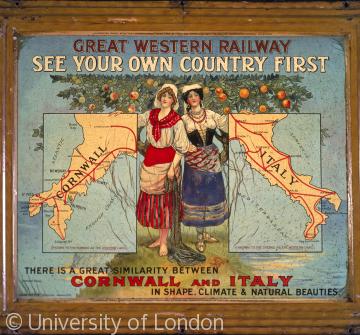Travel and Tourism
 A Great Western Railways advertisment of 1925 encouraging English holiday makers to visit Cornwall
A Great Western Railways advertisment of 1925 encouraging English holiday makers to visit CornwallSome of the earliest travellers were medieval pilgrims who combined religious faith with enjoyment, journeying to Canterbury, Lindisfarne or St Michael's Mount. Later travellers took an interest in antiquities, industry or natural history. Some wrote accounts of their journeys notably John Leland, Celia Fiennes and Daniel Defoe. Wealthy people visited spas at Bath, Tonbridge Wells, or Harrogate. The late-18th century Romantic Movement encouraged middle-class tourism to Exmoor, the Peak District and the Lakes, while the new fashion for sea-bathing brought people to Brighton, Weymouth and other fashionable watering places.
By the late 19th century the railways had opened up most of England to tourism and a week's holiday by the sea or in the countryside. The urban working classes enjoyed wakes week holidays and day excursions by train, sometimes paid for by their employers. Rural workers organised waggon rides, later charabanc trips, to local picnic spots or beaches. The upper classes still took hunting and fishing holidays in England despite the lure of the Riviera and flocked to sporting events like Ascot and Henley. Hotels and guest houses were built to cater for visitors.
The mid 20th century saw most workers entitled to paid holidays. Cheaper travel and holiday camps brought mass tourism to large resorts like Clacton, Essex and smaller ones like Roker and Seaburn, Durham. Day trippers flocked to Dunster and Windermere and to stately homes like Chatsworth. The mass trespass at Kinder Scout, Derbyshire publicised the popularity of rambling amongst the inhabitants of the industrial towns of the Midlands, Lancashire and Yorkshire. Self-catering cottages, farms offering bed and breakfast, and caravan sites cater for a wide range of visitors in most parts of England. Tourism has become a major source of income for rural and seaside areas as well as England's historic towns and cities.



